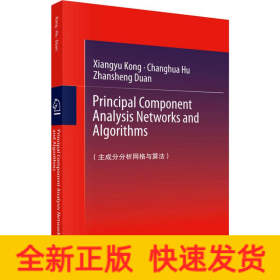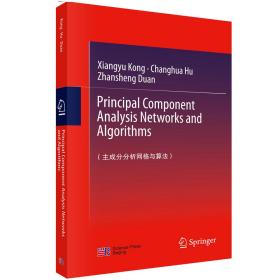
主成分分析网格与算法孔祥玉,胡昌华,段战胜科学出版社
新华系统图书,正版特价新书! 天津,河北,无锡,成都四大仓库发货,70%城市次达!
¥ 106.3 7.1折 ¥ 150 全新
仅1件
北京顺义
认证卖家担保交易快速发货售后保障
作者孔祥玉,胡昌华,段战胜
出版社科学出版社
ISBN9787030602886
出版时间2019-12
装帧平装
开本16开
定价150元
货号1201989195
上书时间2023-05-02
- 最新上架
商品详情
- 品相描述:全新
- 商品描述
-
目录
Chapter 1 Introduction
1.1 Feature Extraction
1.1.1 PCA and Subspace Tracking
1.1.2 PCA Neural Networks
1.1.3 Extension or Generalization of PCA
1.2 Basis for Subspace Tracking
1.2.1 Concept of Subspace
1.2.2 Subspace Tracking Method
1.3 Main Features of This Book
1.4 Organization of This Book
References
Chapter 2 Matrix Analysis Basics
2.1 Introduction
2.2 Singular Value Decomposition
2.2.1 Theorem and Uniqueness of SVD
2.2.2 Properties of SVD
2.3 Eigenvalue Decomposition
2.3.1 Eigenvalue Problem and Eigen Equation
2.3.2 Eigenvalue and Eigenvector
2.3.3 Eigenvalue Decomposition of Hermitian Matrix
2.3.4 Generalized Eigenvalue Decomposition
2.4 Rayleigh Quotient and Its Characteristics
2.4.1 Rayleigh Quotient
2.4.2 Gradient and Conjugate Gradient Algorithm for RQ
2.4.3 Generalized Rayleigh Quotient
2.5 Matrix Analysis
2.5.1 Differential and Integral of Matrix with Respect to Scalar
2.5.2 Gradient of Real Function with Respect to Real Vector
2.5.3 Gradient Matrix of Real Function
2.5.4 Gradient Matrix of Trace Function
2.5.5 Gradient Matrix of Determinant
2.5.6 Hessian Matrix
2.6 Summary
References
Chapter 3 Neural Networks for Principal Component Analysis
3.1 Introduction
3.2 Review of Neural Based PCA algorithms
3.3 Neural based PCA Algorithms Foundation
3.3.1 Hebbian Learning Rule
3.3.2 Ojas Learning Rule
3.4 Hebbian/Anti-Hebbian Rule based Principal Component Analysis
3.4.1 Subspace Learning Algorithms
3.4.2 Generalized Hebbian Algorithm
3.4.3 Learning Machine for Adaptive Feature Extraction via PCA
3.4.4 The Dot-Product-Decorrelation Algorithm
3.4.5 Anti-Hebbian Rule based Principal Component Analysis
3.5 Least Mean Squared Error based Principal Component Analysis
3.5.1 Least Mean Square Error Reconstruction Algorithm
3.5.2 Projection Approximation Subspace Tracking Algorithm
3.5.3 Robust RLS Algorithm
3.6 Optimization based Principal Component Analysis
3.6.1 Novel Information Criterion Algorithm
3.6.2 Coupled Principal Component Analysis
3.7 Nonlinear Principal Component Analysis
3.7.1 Kernel Principal Component Analysis
3.7.2 Robust/Nonlinear Principal Component Analysis
3.7.3 Autoassociative Network based Nonlinear PCA
3.8 Other PCA or Extensions of PCA
3.9 Summary
References
Chapter 4 Neural Networks for Minor Component Analysis
4.1 Introduction
4.2 Review of Neural Network Based MCA Algorithms
4.2.1 Extracting the First Minor Component
4.2.2 Ojas Minor Subspace Analysis
4.2.3 Self-stabilizing MCA
4.2.4 Orthogonal Oja Algorithm
4.2.5 Other MCA Algorithm
4.3 MCA EXIN Linear Neuron
4.3.1 The Sudden Divergence
4.3.2 The Instability Divergence
4.3.3 The Numerical Divergence
4.4 A Novel Self-stabilizing MCA Linear Neurons
4.4.1 A Self-stabilizing Algorithm for Tracking one MC
4.4.2 MS Tracking Algorithm
4.4.3 Computer Simulations
4.5 Total Least Squares Problem Application
4.5.1 A Novel Neural Algorithm for Total Least Squares Filtering
4.5.2 Computer Simulations
4.6 Summary
References
Chapter 5 Dual Purpose for Principal and Minor Component Analysis
5.1 Introduction
5.2 Review of Neural Network Based Dual Purpose Methods
5.2.1 Chens Unified Stabilization Approach
5.2.2 Hasans Self-normalizing Dual Systems
5.2.3 Pengs Unified Learning Algorithm to Extract Principal and Minor Components
5.2.4 Mantons Dual Purpose Principal and Minor Component Flow
5.3 A Novel Dual Purpose Method for Principal and Minor Subspace Tracking
5.3.1 Preliminaries
5.3.2 A Novel Information Criterion and Its Landscape
5.3.3 Dual Purpose Subspace Gradient Flow
5.3.4 Global Convergence Analysis
5.3.5 Numerical Simulations
5.4 Another Novel Dual Purpose Algorithm for Principal and Minor Subspace Analysis
5.4.1 The Criterion for PSA and MSA and Its Landscape
5.4.2 Dual Purpose Algorithm for PSA and MSA
5.4.3 Experimental Results
5.5 Summary
References
Chapter 6 Deterministic Discrete Time System for the Analysis of Iterative Algorithms
6.1 Introduction
6.2 Review of Performance Analysis Methods for Neural Network Based PCA Algorithms
6.2.1 Deterministic Continuous-Time System Method
6.2.2 Stochastic Discrete-Time System Method
6.2.3 Lyapunov Function Approach
6.2.4 Deterministic Discrete-Time System Method
6.3 DDT System of a Novel MCA Algorithm
6.3.1 Self-stabilizing MCA Extraction Algorithms
6.3.2 Convergence Analysis via DDT System
6.3.3 Computer Simulations
6.4 DDT System of a Unified PCA and MCA Algorithm
6.4.1 Introduction
6.4.2 A Unified Self-stabilizing Algorithm for PCA and MCA
6.4.3 Convergence Analysis
6.4.4 Computer Simulations
6.5 Summary
References
Chapter 7 Generalized Principal Component Analysis
7.1 Introduction
7.2 Review of Generalized Feature Extraction Algorithm
7.2.1 Mathews Quasi-Newton Algorithm for Generalized Symmetric Eigenvalue Problem
7.2.2 Self-organizing Algorithms for Generalized Eigen Decomposition
7.2.3 Fast RLS-Like Algorithm for Generalized Eigen Decomposition
7.2.4 Generalized Eigenvector Extraction Algorithm Based on RLS Method
7.2.5 Fast Adaptive Algorithm for the Generalized Symmetric Eigenvalue Problem
7.2.6 Fast Generalized Eigenvector Tracking Based on the Power Method
7.2.7 Generalized Eigenvector Extraction Algorithm Based on Newton Method
7.2.8 Online Algorithms for Extracting Minor Generalized Eigenvector
7.3 A Novel Principal Generalized Eigenvector Extraction Algorithm
7.3.1 Algorithm Description
7.3.2 Convergence Analysis
7.3.3 Computer Simulations
7.4 Novel Multiple GMC Extraction Algorithm
7.4.1 A Weighted Information Criterion
7.4.2 Multiple GMCs Extraction Algorithm
7.4.3 Simulations and Application Experiments
7.5 Summary
References
Chapter 8 Coupled Principal Component Analysis
8.1 Introduction
8.2 Review of Coupled Principal Component Analysis
8.2.1 Mollers Coupled PCA Algorithm
8.2.2 Nguyens Coupled Generalized Eigen-pairs Extraction Algorithm
8.2.3 Coupled Singular Value Decomposition of a Cross-covariance Matrix
8.3 Unified and Coupled Algorithm for Minor and Principal Eigen-pair Extraction
8.3.1 Coupled Dynamical System
8.3.2 The Unified and Coupled Learning Algorithms
8.3.3 Analysis of Convergence and Self-stabilizing Property
8.3.4 Simulation Experiments
8.4 Adaptive Coupled Generalized Eigen-pairs Extraction Algorithms
8.4.1 A Coupled Generalized System for GMCA and GPCA
8.4.2 Adaptive Implementation of Coupled Generalized Systems
8.4.3 Convergence Analysis
8.4.4 Numerical Examples
8.5 Summary
References
Chapter 9 Singular Feature Extraction and Its Neural Network
9.1 Introduction
9.2 Review of Cross-correlation Feature Method
9.2.1 Cross-correlation Neural Networks Model and Deflation Method
9.2.2 Parallel SVD Learning Algorithms on Double Stiefel Manifold
9.2.3 Double Generalized Hebbian Algorithm (DGHA) for SVD
9.2.4 Cross-associative Neural Network for SVD(CANN)
9.2.5 Coupled SVD of a Cross-Covariance Matrix
9.3 An Effective Neural Learning Algorithm for Extracting Cross- Correlation Feature
9.3.1 Preliminaries
9.3.2 Novel Information Criterion Formulation for PSS
9.3.3 Adaptive Learning Algorithm and Performance Analysis
9.3.4 Computer Simulations
9.4 Coupled Cross-correlation Neural Network Algorithm for Principal Singular Triplet Extraction of a Cross-Covariance Matrix
9.4.1 A Novel Information Criterion and A Coupled System
9.4.2 Online Implementation and Stability Analysis
9.4.3 Simulation Experiments
9.5 Summary
References
相关推荐
— 没有更多了 —










![机遇与挑战-(:多变世界里中国与欧盟关系的可持续发展)石坚,[德]海杜克中国社会科学出版社](https://www0.kfzimg.com/sw/kfz-cos/kfzimg/defbaada/53c6b06bbd64467b_s.jpg)









以下为对购买帮助不大的评价